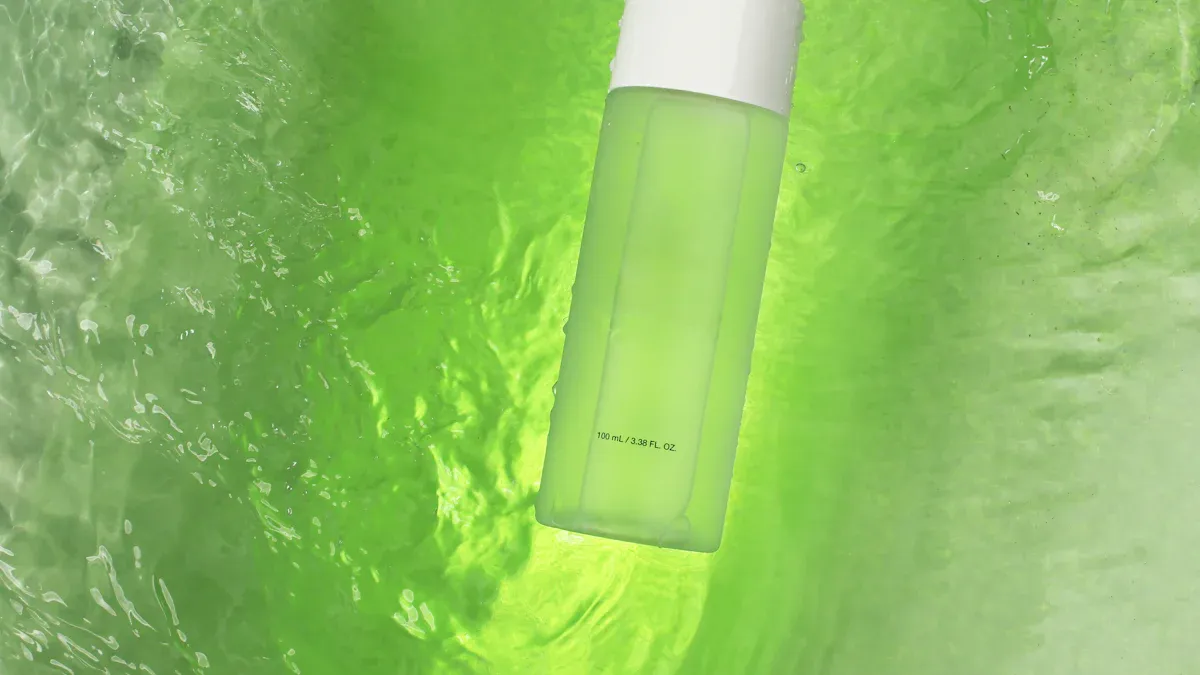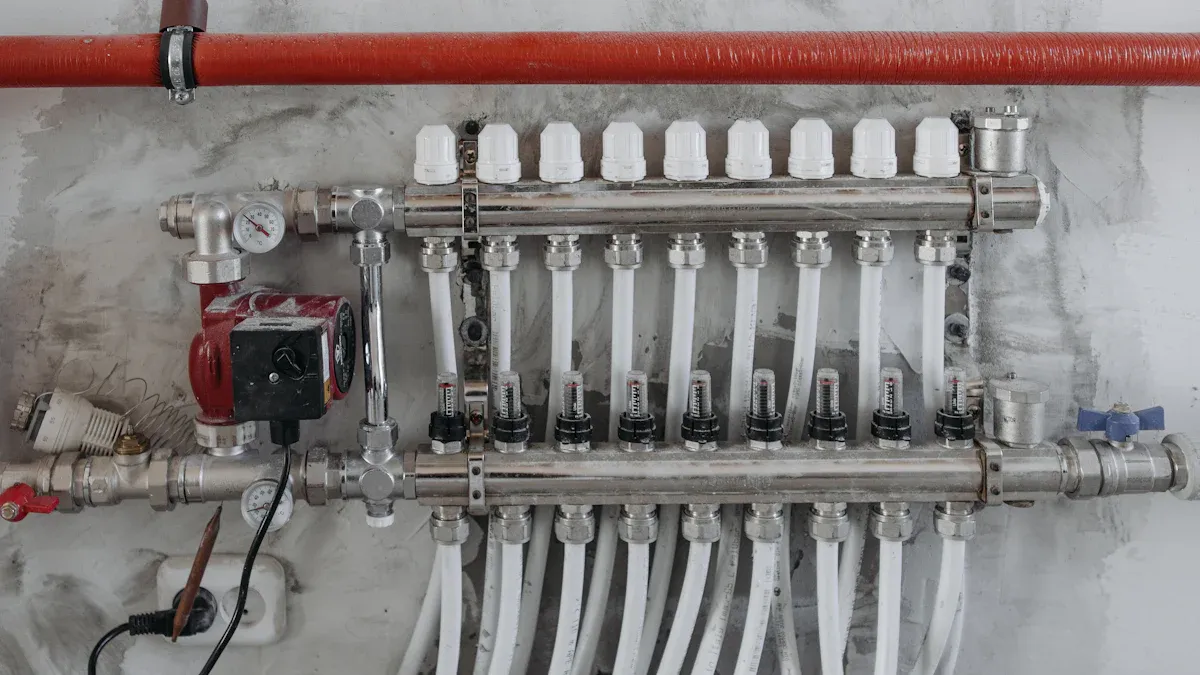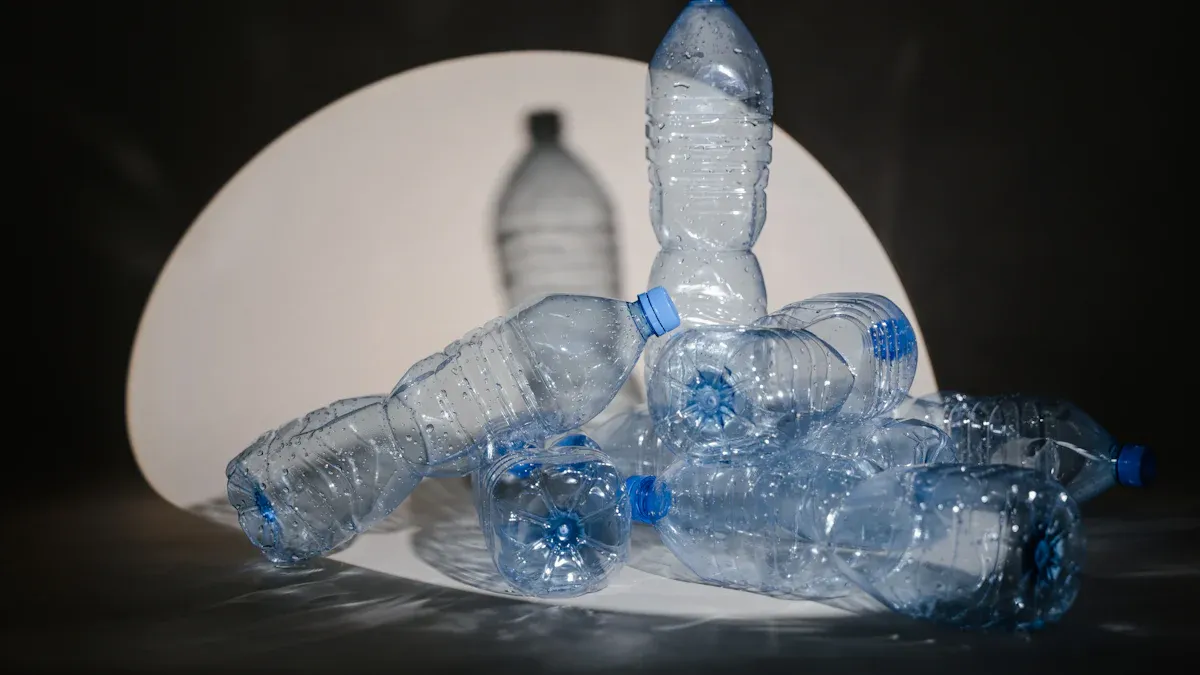
Managing moisture in hygroscopic plastic materials is crucial for ensuring high-quality products. Even minimal moisture content can lead to defects during manufacturing. For example, materials like ABS and PA66 must have moisture levels below 0.1% and 0.2% respectively for injection molding, despite absorbing 0.25% or more from the air. Without good moisture protection, these materials can warp, crack, or weaken. You face challenges like ambient humidity and improper storage, which demand effective moisture protection strategies to maintain production efficiency and product integrity.
Plastics behave differently when exposed to moisture, depending on their hygroscopic properties. Hygroscopic materials, such as nylon, ABS, and PET, absorb moisture from the air. This absorbed moisture can interfere with the injection molding process, making proper drying essential before use. On the other hand, non-hygroscopic substances like polyethylene and PVC do not absorb moisture but may accumulate surface condensation.
Here’s a quick comparison of these two types of plastics:
| Type of Plastic | Moisture Behavior |
|---|---|
| Hygroscopic | Absorbs moisture from the air; requires drying before processing. Common examples: Nylon, ABS, PET. |
| Non-hygroscopic | Does not absorb moisture; may accumulate surface moisture due to condensation. Common examples: Polyethylene, PVC. |
Understanding these differences helps you take the right steps to prevent moisture-related defects during manufacturing.
Excessive moisture in hygroscopic materials can lead to various defects during production. When moisture remains in the resin, it vaporizes during molding, causing issues like splay, streaks, and polymer degradation. Common moisture-related defects include:
Plastics like polycarbonate and nylon are particularly prone to these problems. Proper drying and storage are critical for preventing moisture-related defects and ensuring high-quality products.
Moisture absorption significantly affects the mechanical and physical properties of plastics. For example, nylon 6 absorbs up to 9% moisture, leading to a 2% dimensional change and an 80% drop in tensile strength from dry to saturated states. Similarly, nylon 6.6 experiences a 7% moisture absorption, resulting in a 3.5% dimensional change and a 60% reduction in tensile strength.
Other measurable effects of moisture include:
- A 50% reduction in transverse tensile strength under high humidity.
- A 20% decrease in in-plane shear strength.
- A 10% decline in shear modulus at maximum moisture absorption.
These changes highlight the importance of managing moisture to avoid moisture damages and maintain the integrity of your products.

Proper storage of resin plays a critical role in managing moisture effectively. Hygroscopic materials, such as nylon and PET, absorb moisture from the air, which can compromise their quality. To prevent this, you should store resins in sealed, moisture-proof containers. Use moisture absorbers or desiccants to maintain low humidity levels in storage areas.
For long-term storage, consider climate-controlled environments. These spaces regulate temperature and humidity, offering an additional layer of moisture protection. Always inspect storage containers for damage or leaks, as even minor exposure to air can lead to moisture absorption.
Tip: Label storage containers with the date of storage and material type. This practice ensures you use older materials first, reducing the risk of moisture-related defects.
Drying is essential for hygroscopic materials before processing. Follow these plastic drying tips to ensure optimal results:
Implementing these plastic drying procedures minimizes moisture-related defects and enhances product quality.
Note: Always refer to the manufacturer’s step-by-step guidelines for drying specific resins. This ensures you achieve the best results without compromising material integrity.
Accurate moisture measurement is a cornerstone of effective moisture management techniques. Advanced instruments, such as the HX204, provide precise readings for low moisture content in resins like polyamides and ABS. This device offers a resolution of 0.1 mg and an accuracy of 0.001% MC, making it ideal for monitoring hygroscopic materials.
Other reliable methods include:
- ASTM D6980-17: A standard method for measuring moisture in plastics.
- Karl Fischer Titration (ASTM D6444): A chemical technique for precise moisture analysis.
- Gravimetric Analysis with Desiccant: A cost-effective option for rough moisture estimates.
The benefits of real-time moisture monitoring include improved product quality, increased plant efficiency, and lower energy costs. For example, integrating sensors with PLCs allows for automated control of drying systems, optimizing energy use and reducing downtime.
| Performance Metric | Description |
|---|---|
| Improved product quality monitoring | Proactive assessment of moisture levels prevents product waste, enhancing overall quality. |
| Increased plant efficiency | Real-time moisture measurement reduces downtime and human error associated with manual testing. |
| Lower energy costs | Optimized dryer settings lead to significant energy savings and reduced operational costs. |
| Precise dryer or oven control | Immediate savings from optimized settings, reducing rework and enhancing production efficiency. |
| Low cost and high accuracy | Quick ROI from energy savings and reduced downtime due to elimination of manual testing. |
| Low to zero maintenance | Easy installation and operation of sensors minimize setup time and operational complexity. |
| Process optimization | Integration with PLCs allows for more efficient control and automation of moisture management. |
| Speeded up production | Transitioning to advanced moisture measurement technology accelerates production processes. |
Reminder: Regularly calibrate your moisture measurement instruments to maintain accuracy and reliability.
Dehumidification systems play a vital role in controlling moisture levels in manufacturing environments. These systems help maintain optimal conditions, ensuring the quality of your plastic products. By reducing ambient humidity, they prevent moisture absorption in hygroscopic materials like nylon and PET. This minimizes defects and enhances production efficiency.
Using dehumidification systems offers several advantages for plastic manufacturers. These include:
For example, a confectionery plant reduced its cooling power loads from 37,800 kWh to about 27,000 kWh per month by implementing a dehumidification system. Similarly, a meat processing facility cut HVAC energy costs by 40% while reducing airborne particulate levels by 75%.
You can choose from various dehumidification systems based on your specific needs. Closed-loop dehumidification systems are particularly effective for plastic manufacturing. These systems recycle air within a sealed environment, ensuring consistent humidity control. They also use desiccants to absorb moisture from the air, providing precise and efficient drying.
Other systems, such as liquid desiccant units, offer additional benefits. For instance, Huawei's cleanroom achieved 62% energy cost savings using these units. This demonstrates their effectiveness in reducing operational costs while maintaining ideal conditions.
The effectiveness of a dehumidification system depends on factors such as air flow rate and operating temperature. The table below highlights how these variables impact dehumidification performance:
| Air Flow Rate (m/s) | Operating Temperature (°C) | Dehumidification Effectiveness (%) |
|---|---|---|
| 5 | 60 | 74.8 |
| 5 | 45 | 77 |
| 5 | 30 | 63 |
| 17 | 30 | 11–30.5 |
This data shows that lower temperatures and moderate air flow rates enhance the system's ability to remove moisture effectively.
To maximize the benefits of dehumidification systems, follow these best practices:
By implementing these practices, you can maintain consistent humidity control and protect your materials from moisture damage.
Tip: Combine dehumidification systems with proper storage solutions for maximum moisture protection. Use sealed containers and desiccants to create a comprehensive moisture management strategy.

Selecting the right drying system is essential for achieving high-quality injection-molded parts. Different systems cater to specific drying requirements, ensuring that resin moisture levels are reduced effectively before molding. Here are the most common types of drying systems used in the plastics industry:
| Dryer Type | Dewpoint Capability | Notes |
|---|---|---|
| Twin-tower desiccant dryer | -40 F or lower | Considered the industry standard, available from multiple sources. |
| Desiccant wheel dryer | -40 F | Used in various industries for over 50 years, introduced for plastics around 20 years ago. |
| Compressed-air dryer with membrane | -40 F or lower | Popularized in the U.S. since 2000, available from several suppliers. |
| Vacuum dryer | N/A | Available from few sources, with commercial models introduced in North America since 1999. |
Each system has unique features. Twin-tower desiccant dryers are widely regarded as the industry standard due to their reliability and efficiency. Desiccant wheel dryers, though newer to plastics, have proven effective in maintaining consistent dewpoints. Compressed-air dryers with membranes are compact and energy-efficient, making them ideal for smaller operations. Vacuum dryers, while less common, offer rapid drying by reducing the boiling point of water, which speeds up moisture removal.
Tip: Evaluate your production scale and resin type to determine which drying system aligns best with your needs.
Choosing the right equipment involves more than just understanding the types of dryers available. You must consider several critical factors to ensure optimal performance and cost-efficiency:
By addressing these factors, you can select equipment that meets your drying requirements and supports efficient production.
Reminder: Always consult the resin manufacturer’s guidelines for specific drying parameters to avoid compromising material integrity.
Not all plastics have the same drying needs. Matching the equipment to the resin type ensures effective moisture removal and prevents defects during molding. Here are some key considerations:
For instance, desiccant dryers are ideal for hygroscopic materials like PET and nylon, while hot air dryers work well for non-hygroscopic plastics like polypropylene. Vacuum dryers can be a good choice for specialty resins that require rapid drying without excessive heat.
Tip: Consider the resin’s moisture sensitivity and drying requirements when selecting equipment. This approach ensures consistent quality and reduces the risk of defects.
Maintaining low humidity in storage areas is essential for protecting hygroscopic materials from moisture damages. Hygroscopic plastics like nylon and PET absorb moisture from the air, which can lead to defects during molding. To prevent this, you should implement effective environmental controls. Continuous recording instruments provide real-time data on humidity levels, reducing the need for manual monitoring. Snapshot monitoring devices, while less automated, offer a quick overview of storage conditions. Establishing an environmental monitoring program ensures a systematic approach to managing humidity.
| Monitoring Strategy | Purpose |
|---|---|
| Continuous recording instruments | Provide ongoing data on climate conditions, reducing reliance on human participation. |
| Snapshot monitoring devices | Offer rough environmental pictures but require human input for data collection. |
| Environmental monitoring program | Establishes a systematic approach to assess and manage storage conditions effectively. |
Tip: Place hygroscopic materials in climate-controlled storage areas to maintain consistent humidity levels and prevent moisture absorption.
Proper sealing and packaging methods play a critical role in moisture protection. Using moisture control systems like silica gel packets helps regulate humidity inside packaging. Low MVTR (Moisture Vapor Transmission Rate) materials prevent moisture exchange, keeping hygroscopic materials safe. High-performance barrier films offer additional protection by maintaining optimal humidity levels and extending product shelf life.
| Packaging Method | Benefit Description | Example Use Case |
|---|---|---|
| Moisture control systems | Regulate humidity, preventing condensation and mold growth. | Desiccants like silica gel |
| Low MVTR materials | Prevent moisture exchange, maintaining optimal humidity levels inside the package. | Dry products, fresh produce, pharmaceuticals |
| High-performance barrier films | Control MVTR effectively, ensuring product stability and prolonged shelf life. | Vacuum packaging for meat products |
Reminder: Always inspect packaging for damage before use. Even small tears can compromise moisture protection.
Monitoring environmental conditions ensures effective moisture protection for hygroscopic materials. Key metrics like Water Vapor Transmission Rate (WVTR) measure the effectiveness of barriers in preventing moisture penetration. High-performance barriers achieve WVTR rates below 0.02 grams per 100 square inches over 24 hours. Testing standards such as ASTM D1653 and ASTM E96 evaluate barrier performance under specific conditions. Instruments like moisture analyzers and meters provide accurate moisture content readings, helping you identify potential issues early.
Note: Regularly calibrate your monitoring instruments to maintain accuracy and reliability.
Transporting plastic materials requires careful planning to prevent moisture-related defects. You can take several steps to ensure materials remain protected during transit:
Proper material handling during transit reduces the likelihood of defects such as warping, cracking, or clumping.
Tip: Inspect containers for leaks or damage before loading. Even small openings can allow moisture to enter and compromise your materials.
Moisture-resistant packaging plays a vital role in protecting plastic materials from environmental exposure. High-barrier films and foil-lined bags are excellent options for safeguarding products. For example, high-barrier films used in laundry detergent packaging have reduced clumping and improved product stability. Similarly, foil-lined bags with desiccants have enhanced seed viability in humid conditions, increasing germination rates by 40%.
When selecting packaging, prioritize materials with low moisture vapor transmission rates (MVTR). These materials prevent moisture exchange, ensuring the integrity of your products during storage and transit.
Reminder: Regularly test packaging performance using standardized methods like drop tests and compression tests. This ensures durability and compliance with industry standards.
Proper handling procedures are essential to prevent moisture exposure during transport. Train employees to follow best practices, such as sealing containers immediately after loading and avoiding prolonged exposure to humid environments. Collaborate with suppliers to identify innovative materials that enhance protection and sustainability.
Performance testing, such as impact resistance assessments, helps validate the effectiveness of your handling methods. Regular training sessions reinforce the importance of compliance and reduce the risk of defects caused by improper handling.
Note: Establish a checklist for handling procedures to ensure consistency and accountability across your team.
Effective moisture management in plastic manufacturing ensures consistent product quality and reduces damages caused by excess moisture. By adopting advanced drying techniques and monitoring relative humidity, you can prevent defects and improve production efficiency. For example, in-line moisture analyzers help maintain uniform moisture levels, minimizing material waste and ensuring compliance with quality standards.
| Benefit | Description |
|---|---|
| Consistent Product Quality | In-line moisture analyzers help maintain uniform moisture levels, leading to higher product quality. |
| Reduced Material Waste | By monitoring moisture content, manufacturers can minimize defects and waste during production. |
| Compliance with Quality Standards | Ensures that products meet stringent moisture content requirements, enhancing quality assurance. |
Investing in proper equipment and implementing best practices protects your materials from damages and ensures long-term success. Start optimizing your processes today to achieve superior results.
Store hygroscopic plastics in sealed, moisture-proof containers. Use desiccants to maintain low humidity levels. For long-term storage, consider climate-controlled environments to prevent moisture absorption.
Use advanced tools like moisture analyzers or follow ASTM standards such as D6980-17. These methods provide accurate readings, helping you monitor and control moisture levels effectively.
Drying removes absorbed moisture, which can cause defects like warping or cracking during molding. Proper drying ensures the material’s integrity and improves the quality of the final product.
Look for splay marks, air bubbles, or streaks on the surface. Structural weaknesses, such as cracks or warping, also indicate moisture-related issues during manufacturing.
Dehumidification systems reduce ambient humidity, preventing moisture absorption in hygroscopic materials. This minimizes defects and enhances production efficiency.